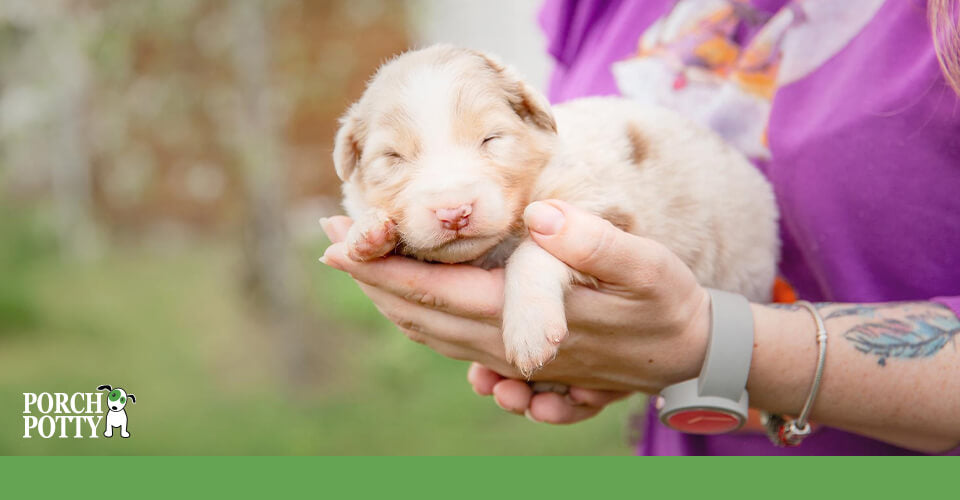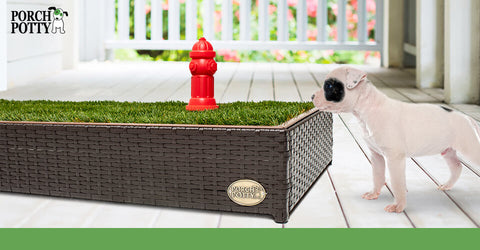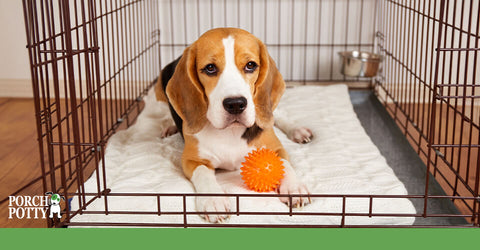
A young woman holds a new puppy in the palm of her hand.
Welcoming a new puppy into your home is an exciting adventure filled with joy and new responsibilities, among which potty training holds paramount importance for a harmonious living situation. For first-time dog owners, the prospect of potty training can seem daunting, faced with the challenges of accidents and understanding your puppy's needs. However, armed with patience and consistency, achieving a well-trained pup is entirely within reach. This article aims to demystify the process, providing a detailed, step-by-step guide to potty training your puppy. From establishing routines to recognizing the signs that it's time to go, we'll walk you through every phase of the journey, ensuring that you and your new furry friend can enjoy a clean, happy home together.
Preparation Before Bringing the Puppy Home
Before the arrival of your new furry family member, taking the time to prepare can make the potty training process smoother and more effective. Here are the key steps to consider:
Choosing the Right Spot
Outdoor Training: Select a quiet, accessible area in your yard away from busy spots to help your puppy feel at ease during potty breaks.
Indoor Training: For those without easy outdoor access, consider an indoor option like a Porch Potty that simulates a natural environment for your puppy.
Supplies You Need
Crate: Essential for creating a safe haven for your puppy and effective in preventing accidents, as dogs naturally avoid soiling their sleep area.
Treats: Crucial for positive reinforcement, rewarding your puppy for going potty in the correct spot.
Cleaning Supplies: An enzymatic cleaner is a must-have to properly clean accidents and eliminate odors that could attract your puppy back to the same spot.
Creating a Schedule
Establishing a routine for feeding and potty breaks is vital. Puppies usually need to go:
- Immediately after waking up
- After eating
- After playing
Consistency with these times helps your puppy learn to control their bladder and bowels, making potty training more predictable and manageable.

A young puppy sniffs a Porch Potty, checking out its new potty area.
Introduction to the Potty Area
Successfully potty training your puppy begins with a proper introduction to their designated potty area, whether it's outdoors or on a specially prepared indoor spot like a Porch Potty. Here's how to navigate this crucial step:
First Introduction
Make it Immediate: As soon as your puppy arrives home, take them directly to the potty area. This helps establish from the very beginning where it's appropriate to relieve themselves.
Stay Calm and Patient: Use a calm voice and patient demeanor. Your puppy might take a moment to explore and get comfortable with the area.
Consistency is Key: Regularly bring your puppy to the same spot. Consistency helps reinforce the habit, making the potty area familiar and the desired spot for them to do their business.
Signs to Watch For
Puppies will naturally show signs when they need to go. Recognizing these early is essential for timely potty breaks:
Sniffing and Circling: Common behaviors when searching for a spot to relieve themselves.
Whining or Barking: Can indicate discomfort and the need to go outside.
Restlessness: Pacing or seeming unable to settle might mean it's time for a quick trip to the potty area.
Positive Reinforcement
Using treats and praise effectively encourages your puppy to repeat desired behaviors:
Immediate Reward: Immediately after your puppy goes potty in the correct area, reward them with a treat and verbal praise.
Stay Positive: Avoid punishment for accidents. Positive reinforcement builds confidence and strengthens the bond between you and your puppy.
Consistent Rewards: Consistently rewarding your puppy for the correct behavior reinforces the habit, making successful potty training more likely.
Establishing a Routine
Consistency is Key
A consistent schedule is paramount for potty training success, serving as the cornerstone of a reliable routine for your puppy. By feeding your puppy at the same times each day and promptly taking them to their potty area afterwards, you're helping to regulate their body's elimination schedule. Consistency extends beyond feeding and potty breaks; it also involves maintaining regular intervals for play and sleep. This predictable structure not only aids in quicker potty training but also provides a sense of security for your puppy, making them feel more at ease with the process.
Dealing with Accidents
Accidents are a natural part of the potty training journey, and how you respond to them can significantly impact your puppy's learning curve. It's essential to remain calm and refrain from scolding or punishing your puppy, as negative reactions can lead to anxiety and confusion. Instead, quietly clean up the mess with an enzymatic cleaner to remove any scent markers that might entice a repeat performance. If you catch your puppy in the act, gently interrupt them and immediately take them to their designated potty area, reinforcing where it's appropriate to go.
Adjusting Schedules
As your puppy grows and their capacity to hold their bladder increases, it will become necessary to adjust their potty break schedule accordingly. Start gradually extending the time between potty breaks, paying close attention to your puppy's behavior for signs they need to go. This gradual adjustment helps your puppy learn to hold it for longer periods and adapt to a more flexible schedule that suits their developing physical abilities. Regular assessment and minor adjustments ensure that the potty training routine evolves with your puppy's needs, leading to a fully house-trained adult dog.
Crate Training as a Tool
Crate training is a highly effective tool in the potty training arsenal, serving multiple beneficial purposes beyond mere convenience. At its core, crate training exploits a dog's natural instinct to avoid soiling their sleeping area, thus encouraging them to hold their bladder until they are taken to an appropriate spot to relieve themselves. Moreover, a crate provides a puppy with a safe and secure space of their own, reducing anxiety and preventing destructive behaviors when they cannot be supervised. When used correctly, a crate helps establish a routine, significantly aiding in the potty training process by promoting control and patience in young dogs.
When embarking on crate training, there are several dos and don'ts to keep in mind to ensure it's a positive experience for your puppy. Do make the crate a comfortable and inviting space, using soft bedding and safe toys. Introduce your puppy to the crate gradually, starting with short periods and gradually increasing the duration as they become more comfortable. Don't use the crate as a form of punishment; the goal is for your puppy to see their crate as a safe haven, not a place of isolation. Ensuring the crate is the right size is also crucial; it should be large enough for your puppy to stand, turn around, and lie down comfortably, but not so large that they can use one end as a bathroom and the other as a sleeping area.
As your puppy becomes more reliable in their potty habits, gradually increasing their freedom around the house is a natural progression. This transition should be done slowly, starting with short, supervised periods of freedom and extending them as your puppy demonstrates consistent potty behavior. The key is to balance this newfound freedom with supervision, ensuring that your puppy doesn't develop the opportunity to relapse into old habits. Continued use of the crate during unsupervised times or when you are not home helps maintain the routine and provides your puppy with a familiar, secure environment as they adapt to more freedom.

Crate training is a valuable tool to help you potty train your puppy.
Common Challenges and Solutions
Potty training a puppy comes with its set of challenges, some of which can test the patience of even the most devoted owners. Here are some common hurdles you might encounter and effective strategies to overcome them:
Addressing Night Time Potty Breaks
Establish a Routine: Take your puppy out for a final potty break right before bedtime to minimize the need for nighttime outings.
Limit Water Intake: Reduce your puppy's water intake in the late evening hours, but ensure they have access to water throughout the day to stay hydrated.
Respond Promptly: If your puppy whines or signals during the night, take them out to their potty area immediately, then calmly return them to their crate to discourage the idea that nighttime is playtime.
Separation Anxiety and Potty Training
Gradual Desensitization: Slowly acclimate your puppy to being alone for short periods, gradually increasing the time to build their comfort and confidence.
Create a Comforting Environment: Leave items that smell like you with your puppy and consider background noise, like a radio, to offer comfort when they're alone.
Stay Positive: Use positive reinforcement when your puppy remains calm or uses their potty area correctly, even when alone, to reinforce good behavior.
Patience and Persistence
Stay Consistent: Consistency in routine and reinforcement is key, even when progress seems slow.
Celebrate Small Victories: Every step in the right direction is a success. Celebrate with your puppy to encourage continued progress.
Seek Professional Advice: If you're facing persistent challenges, consider consulting a professional dog trainer for personalized guidance and support.
Final Thoughts
In the rewarding journey of raising a puppy, successful potty training lays the foundation for a harmonious relationship between you and your new furry friend. We've explored the essential pillars of this process: thorough preparation before your puppy arrives, establishing a consistent routine, the power of positive reinforcement, and the virtue of patience. These elements are crucial for effective training, emphasizing the importance of consistency and maintaining a positive attitude, even when faced with challenges. Remember, the time and effort you invest in potty training your puppy not only facilitate a clean and peaceful home environment but also strengthen the bond you share with your pet.
As we conclude this guide, we encourage you to share your own potty training experiences and tips in the comments below. Whether you're celebrating triumphs or seeking advice for obstacles, your insights can offer valuable support to fellow dog owners embarking on this journey. For additional resources, tools, and innovative products designed to streamline the potty training process, visit PorchPotty.com. Together, let's celebrate the significant first step in a long and rewarding relationship with our pets.
For more information about training your puppy, check out these articles:
Unlocking the Power of Positive Reinforcement
The Ultimate Guide to Potty Training Your Puppy
Effective Solutions for Eliminating Pet Odors and Stains from Accidents



